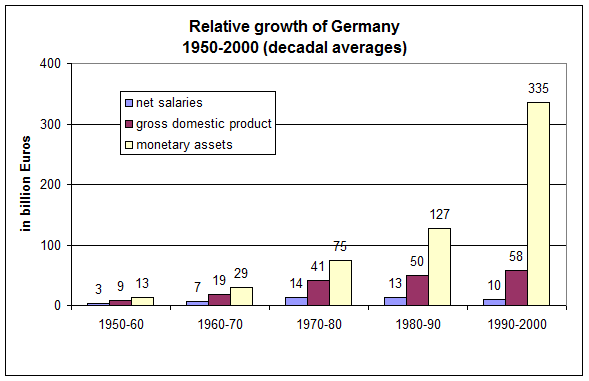The system is broken and can’t be fixed. It needs replacement.
I wrote this paper in 2006 while in prison. It was inspired by a series of books I received from supporters who wanted to “enlighten” me about economic issues. It is based on my own reasoning, but very strongly influence by the works of Helmut Creutz, who is a professor for economics at Kassel University, Germany.
I have always worried about the dynamics of public and private debt, but only after reading Creutz’s book Das Geld Syndrom did all the pieces finally fall into place and made sense. The book is also available in English, although for some reason published by an Indian publisher only: The Money Syndrome. Towards a Market Economy Free from Crises, Hyderabad, India, 626 pages, 94 illustrations, GVM Krishna Publishing, 2009. I found out after my release why. I tried to get my paper published in the U.S., but I encountered nothing but ridicule and hostility. One publisher actually stated that there are no limits to economic growth. If we ever hit the physical limits of planet Earth, then we simply reach out for other planets and include them into the economy as well. That’s predatory capitalism, pure and simple. And it’s the primary threat to the world.
After having come to the conclusions laid out in the following paper, I wrote a letter to my wife in the U.S. explaining her the ineluctable dynamics we are caught in economically and warned her of an impending financial meltdown sure to come sooner or later: I strongly advised her to please regulate her finances in a way that would minimize the impact for us. She did not listen, and when the 2008 financial meltdown hit two years later, she was unprepared. She felt guilty about it later. “All the economic experts worldwide were clueless, but you called it from your prison cell,” she said. Well, yes, I did, thanks to Prof. Creutz. And it is plain to see that the 2008 crisis was only the beginning of what is yet to come. It’s going to get much worse. Mark my words.
Abstract
The current financial system is the enemy of mankind. Worse still: it is the enemy of life on this planet. The reason: By definition it operates with positive interest rates only. As a result, the system is condemned to have steady growth, or else debt spirals out of control. But in a limited system, nothing can grow infinitely. Unchecked growth is cancerous, and creatures with cancer must die. So must this system.
During prehistoric times humans had only their labor and the products they had manufactured or gathered to trade with. Step by step they agreed upon certain tokens which stood for a certain amount of labor or products. They used items that did not deteriorate, like mussel shells, pearls, amber, gem stones, and later precious metals. Money was therefore probably invented step by step, gaining general acceptance once the stage of precious metals as a trade token had been reached. To this day several languages use identical or similar words for money as for certain precious metals (French: argent = money and silver, German: Geld = money, coming from Gold; the old Dutch currency Gulden derives from the same word).
The most important feature of non-deteriorating materials as money – that its value per se does not decrease with time – is also its most problematic property. Whereas it is impossible to hoard labor and not conducive to stockpile common products, as almost all of them deteriorate, decay, rot, spoil or at least go out of fashion with time, money is there to stay. In the exchange triangle of goods, labor and money, the latter therefore has an edge over the others. Whereas goods must be sold and labor be offered, one can stash away money and wait for better prices, or those who have money to lend can easily ask for interest to be paid. (This is not to say that money-free trade is automatically interest-free. It all depends on the urges of all sides involved.)
The trick of those in control of defining what money is (and how much of it is circulating) in order to prevent that people stockpile it, is to always have some inflation. This way money, too, loses some of its value; hence all three in the above-mentioned triangle are once more on a par level. This way people with a surplus of money don’t put it under their mattress but bring it to banks or invest it otherwise with the intention to at least partly compensate for inflation losses, if not even to get back more than inflation is gnawing away. The tool used for this compensation is again interest. Although the term used for certain kinds of investment may be different (like dividend or investment return), it all amounts to the same thing. So strictly speaking inflation does fix only one problem of money: that it won’t be hoarded. Money’s tendency to incur interest remains unaffected…
Let us now focus on this interest. People with a surplus of money usually invest it to get some interest back. There is generally only a small interest rate for small investments, like when you keep small amounts in a savings account, but interest rates increase as the amounts invested increase, eventually exceeding the inflation rate. This means that people with a large money surplus get a higher return than those with a small surpluses (except perhaps when we are talking about astronomical sums of money, at which point things can become somewhat unstable, the reason of which we will touch upon later).
Those who lack money need to borrow it and hence have to pay interest. In these cases the situation is inverted to the one before, as small loans, like those on credit cards, usually come with exorbitant interest rates of a few percent per month, which amounts to 20% per year and more (which qualifies as usury), whereas large loans come with better conditions, i.e. lower interest rates. They usually all have in common, though, that they hover well above the inflation rate, as most investors are unwilling to lose money due to inflation, and that the borrowing interest rates are on average always a notch higher than the lending rates. The banks and other investment institutions basically sack the difference (plus your government with taxes).
Let us now step back and summarize the last two paragraphs:
- People with surplus money – the affluent – lend money and get paid for it with an interest, so at the end they have more money than before. The affluent therefore get more affluent. (Except in times of stock market crashes, of course.)
- People with a lack of money – the indigent (or those who merely think they need more than they have) – borrow money and have to pay interest for it, so at the end they are left with even less money than before. The indigent therefore get even more indigent.
The only way to prevent that those borrowing money make a net loss is by investing it in some way resulting in higher investment returns than the borrowing interest rate. For government authorities this means that the increase in tax revenue must at least match interest payments on public debt. For companies this means that their growth of profits must exceed their interest rates, and for individuals this amounts to an increase of wages and salaries beyond the interest rates due. Since the growth of salaries, profits and tax revenues roughly correlates to the growth of the domestic product of a national economy, this means the following: Only if the average borrowing interest rates of a national economy are lower than the growth of its gross domestic product will those in need of borrowing money NOT steadily lose more money due to the interest payments. Or put the other way around: in a society whose economic growth is lower than average borrowing interest rates the poor get poorer.
Those lending money, however, will always win money as long as the lending interest rates are above inflation (and of course the borrowing rates, which on a societal average they always are).
Hence, in order to prevent that the wealth of a nation gets steadily maldistributed from bottom to top, every society under this interest system is forced to have an economic growth of at least the size of its average borrowing interest rates.
Looking at the economies of almost all industrialized nations since the late 1970s, we realize that their growth rates have been well below that level, which means that those nations have since been suffering a slow but continuous impoverishment of their lower and middle classes to the benefit of the upper classes.
The paradigm of steady economic growth, in fact, is a curse, because our planet Earth is a limited system with limited resources, which cannot sustain unlimited growth. It is therefore only a matter of time when the growth of the world economy as a whole cannot keep up with what would be necessary in order to prevent the maldistribution of wealth from escalating.
Under the circumstances described above it is prudent never to incur any private debt. But this helps only so far, because even if you are smart enough never to have any customer debt, there is no way you can escape the coercive payment of huge amounts of interest flowing mainly to the upper social classes. First of all the government forces you via your taxes to pay such interests (in the meantime more than 10% of all our taxes are nothing but interest payments to rich investors in government bonds both domestic and abroad). Corporations in debt force you, too, to pay their interest due. They simply add it to the prices of their products and/or by cutting salaries. In fact, if we distribute all interest payments due on the monetary assets held by all investors, this amounts to almost a third of the average household income. Imagine we all would have to pay a fixed 30% tax on all items and services purchased due to be paid to – the rich. Because that is effectively what we are doing all the time: paying a rich tax of 30%!
As bad as all this may sound, it’s actually even much worse. In order to recognize this, I’ll have to bother you with a little math. I’ll start with a riddle for illustration purposes. Once upon a time there was a fortune teller in ancient Egypt who had been of great service to the Pharaoh. In order to show his gratitude, the Pharaoh told the fortune teller that he had a wish free. The fortune teller responded that he wanted one grain of wheat on the first square of a chess board and double the amount of the previous square for each of the subsequent 63 fields (2 on the second, 4 on the third, 8 on the fourth, and son on). The Pharaoh granted this wish, as he thought that wheat was cheap. But little did he know…
Now comes the riddle: How many grains of wheat did the Pharaoh have to pay? Take a second to make your guess. I’ve asked this question multiple times, and the answers I’ve received usually have been in the order of millions of grains, rarely ever billions, and this is true even for scientists who should be better guessers in such a case.
The exact amount of wheat grains: 2 to the power of 64 minus one (264 -1), which are almost 16 quintillion grains, which is a 16 with 18 zeros. Assuming that 40 wheat kernels weigh one gram, this amounts to roughly 400 billion metric tons of wheat, which would fill a cube five miles long, deep, and high. (The Pharaoh needed a huge chess board…) Needless to say that the Pharaoh was bankrupt, as this would have encompassed the wheat harvests of all of ancient Egypt for countless years.
You may ask now what this has to do with our problem. Mathematically speaking, a function which doubles its value at a constant interval – here with each square of the chess board – is called an exponential function. Compounded interest is just as much an exponential function as the one used in the above story. Hence, if a debt isn’t paid back and the interest to be paid isn’t paid either but added to the debt, the dynamic of such debt is as described above: it skyrockets ever faster, becoming uncontrollable. The same is true, on the other hand, for investments. If I invest money at a given percentage of interest but do not use the interest paid for consumption yet reinvest it, that credit of mine will show the same unbridled, explosive growth.
Private persons and corporations who cannot pay the interest rates but would have to finance it with new debts are considered insolvent and therefore go bankrupt. It is different with public debt, though. Here it frequently happens that interest payments due cannot be paid with tax revenues in full, so they are “financed” by making new debts – at which point the government is confronted with the above chess board dynamics of debt. The limit, of course, is reached at the latest when interest payments due grow to such proportions that those buying government bonds doubt that the tax payers will be able to pay the interest, and at such a moment entire countries can collapse financially, as Iceland did in early 2009, for instance.
The story is different for creditors. There is no inherently built-in limit to which degree their investment can grow – in theory. Once a rich person or institution has amassed a certain wealth, spending all the interest coming in from their investments becomes kind of impossible, so the money is reinvested, and this is when the system starts spiraling out of control, as such investments now show the dynamic of the above chess board example. And in fact: statistics of monetary assets show that they have been doubling roughly every 10 years (which amounts to an average interest rate of some 7% per year). But where does the money come from which the rich and super-rich are amassing? Well, it is paid by those owing interest, that is: the debtors (who, in addition, also have to pay fees for any middle man or company = banker or broker). Hence, exponentially exploding wealth comes with equally and strictly parallelly exploding debt. Both quantities are strictly tied together, as money doesn’t come from nothing.
Since the demand for interest payments on investments has been growing explosively, the pressure on banks and investment companies has been rising to get more and more debtors who would foot the bill, i.e., borrow money and pay interest. This is the reason why obtaining credit cards and real estate mortgages has become increasingly easy over the past decade and why investment schemes and methods have become increasingly risky: the investors – that is to say: the rich and super-rich, which equals to say the powerful and super-powerful – demanded ever more interest to be paid on their ever increasing wealth, so the market has been deregulated and the normal consumer lured ever deeper into the debt trap.
But all scheming and luring is futile in the long run, because every human being can work only so much and can pay only some part of his income as open or hidden interest payments, which is to say: the money available to fuel the voracious, unlimited, exploding appetite of the investments of the rich and super-rich is limited, so at some point the system has to crash. It’s nothing but a world-wide, all-encompassing pyramid scheme, bound to fail.
In 2008 we were witnessing the beginning of such a crash, as the indebted masses could no longer shoulder the ever increasing need to finance the explosively growing assets of the rich. First the poor collapsed, and next the investments of the rich evaporate. It’s all in the math, and it’s all inevitable.
At this point an explanation of the terms “poor” and “rich” is due: There is a magic limit of monetary assets one has to own – earning interest, of course – to offset the hidden, compulsory, ineluctable interest payments we all have to make due to taxes, reduced salaries, and augmented consumer prices. As a society’s debt level rises, this limit rises as well. Around the turn of the millennium that mark stood around some 200,000 dollars which one had to have invested at average interest rates in order to compensate for the ubiquitous interest payments we all make. But it will have risen ever since due to the exploding public, private, and corporate debts. This, too, is a consequence of the progressing redistribution of wealth. Those beneath that magic, steadily rising level are losing wealth (“the poor”), those above it (“the rich”) are gaining it (always speaking in terms of societal averages, of course). Right now less than 10% of all U.S. households are above that level, and the mark is shifting upward, steadily reducing the percentage of households who still win in this ultimate pyramid scheme.
High interest rates on loans and credits have always been considered immoral or even illegal. Yet the only real difference between high interest rates and low ones is that the doubling period of wealth and/or debt varies. The principle fact that this system inevitably leads to redistribution of wealth from bottom to top until the lower classes of society collapse and the rich lose a great deal of their investments as a result cannot be changed. An annual net interest rate of 3%, for instance, has a doubling period of some 23,5 years; a rate of 5% one of some 10 years, and a rate of 10% mere 7 years.
- Hence, interest rates above the inflation rate inevitably lead to a merciless need for economic growth in disregard of natural limits, leading to nature’s exploitation and destruction.
- Yet since natural limits will have the upper hand eventually, in the end this will lead to a continuous redistribution of wealth from poor to rich, and thus to an eventual financial and societal collapse. The only variable in the game is how long it takes to reach this point.

Source: Helmut Creutz, “Tumorartige Selbstvermehrung der Geldvermögen“ [tumor-like self-growth of monetary assets], Humane Wirtschaft, 1/2009, pp. 30-32
To illustrate what I’ve described above let’s look at the chart provided, which gives some key figures of the German economy. Utterly destroyed during and after WWII, Germany started kind of from scratch in 1949. During the country’s first three decades of fast growth (causing substantial environment damage), both net salaries as well as the gross domestic product roughly doubled every 10 years, which amounts to an average growth rate of some 7%. Already during this time monetary assets grew at an even more aggressive rate. The picture changes, starting in the 1980s, when economic growth slowed down to a scant 25% per decade, and in the 1990s to 16% per decade, which amounts to an annual growth of some 2% and just over 1%, respectively. Since the assets kept exploding exponentially (they actually accelerated even more caused by the huge German foreign trade surpluses since the 1990s), society at large had to foot the bill by a net reduction of salaries. Here the redistribution of wealth from poor to rich is clearly visible (including indirectly the one from poor countries to rich countries, which is only hinted at by the above mentioned German trade surplus).
Conclusions: The current financial system is adequately dubbed “interest slavery”. In this system, private debt is either folly (if preventable) or tragedy (if inevitable). Public debt is a crime, as each tax payer is forced with government guns drawn to pay some of his salary to the rich and super-rich. Corporate debt, however, is the system’s hen constantly laying golden eggs, as we all keep paying a “rich tax” with each product and service we buy without even realizing it.
In former eras creditors and debtors used to know each other, as they made their deals directly with each other. Today, however, bankers and investment brokers are the intermediaries anonymizing this nefarious trade, making us think that usury is a thing of the past. But it is not! Any interest rate above the inflation rate is usury, if seen on the level of an entire economy. As we remember the 2008 global financial meltdown, we ought to be aware that no government bailout will stop this collapse in the long run. Quite to the contrary. Increasing public debt in order to shore up the immoral investments of the rich and super-rich amounts to letting the poor, exploited masses pay even more than they already do – so the rich can keep raking in their compound interest. Wasting trillions of dollars owned by the lower and middle class to prop up the investments of the suffering millionaires and billionaires is one of the major crimes of this still young century. (And it really doesn’t make much difference whether we are talking about 800 billion which Obama spent in early 2009 or about 700 which the opposition was prepared to grant. Either way, they are all criminals worse than a million bank robbers.)
Let me state clearly that I do not argue that the rich have no right to be rich. Everyone has the right to keep the money they rightfully earned with legitimate work. Yet earning money just by letting “the money” work is a crime, as it is not the money that works but rather somebody else who is in debt or who is forced by illicit laws to pay other people’s debts (via taxes, lower wages, and excessive consumer prices).
The only way out of this worldwide vicious circle of interest slavery is to overhaul the system. One profound change could be to make sure by political means that the average investment market interest rates do not exceed inflation rates. Another could be to outlaw fixed-rate loans and replace them with loans whose interest rates depend on the profits the debtor is making. This is a common arrangement for investments into companies already today, who pay dividends to their shareholders only if making a profit – or nothing at all in cases of loss. No profit, no interest could also be the rule for public and consumer loans. It then would be a matter of legislative regulation how to define a “profit” in those cases.
The rich and powerful won’t love this message, as it puts a stop to their fountains of fortune bubbling for them effortlessly, but it will be welcome news for the lower and middle classes, whose ever increasing financial burdens threaten to crush them. So resistance from those in power will be severe, make no mistake. Yet there is no alternative if we want to restore equity and justice.
A final word about the currently existing public debt: Some say that our descendants will pay dearly when trying to pay back this debt. Fact is, however, that nobody has an interest in ever paying back this debt. For those holding the government bonds it is more lucrative to keep raking in the interest, and for the public the alternative to paying interest would be this: transferring 10 trillion dollars from the tax payers (mainly the middle class) to the rich and super-rich. Already the mere thought of such a massive transfer of wealth is deeply appalling. It would impoverish large portions of America’s middle class and would make the rich and super-rich merely eager to look for other investment opportunities for these regained 10 trillion dollars in order to once again draw interest – and guess where they would find those opportunities…






